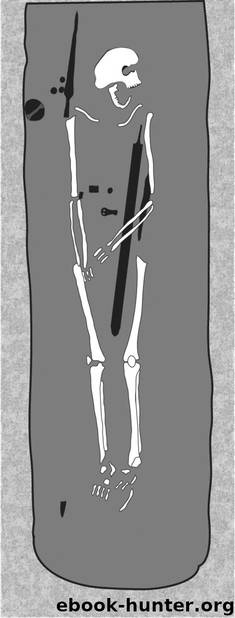Worlds of Arthur by Guy Halsall

Author:Guy Halsall
Language: eng
Format: mobi, epub
Tags: Europe, Ancient, Social Science, General, Great Britain, Medieval, Social History, Archaeology, History
ISBN: 9780199658176
Publisher: OUP Oxford
Published: 2013-02-15T00:42:36+00:00
A: The Origins of the southernmost English Kingdom (Kent) (32 words)
B.1: Introductory comment about Arthur (16 words) B.2: Battle 1 (9 words)
B.3 Battles 2–5 (18 words)Z
B.1 & B.2: 25 words
B1-B5: 61 words
B.4 Battle 6 (7 words) B.3-B.5: 36 words
B.5 Battle 7 (11 words)
C = Battle 8 (Castell Guinnion) and Arthur (47 Words)
B.51 Battle 9 (7 words)
B.41 Battle 10 (9 words)B.31-B.51: 25 words
B.31 Battle 11 (9 words) B11-B51: 57 words
B.21: Battle 12 and Arthur (19 words)B.11 & B.21 - 32 words B.11 Summing up comment (13 words)
A1: The origins of the northernmost English kingdom (Bernicia) (43 words)
Figure 8.2 The structure of HBchapter56 coincidence. The three sections about the battles are of almost exactly the same length. This permits vital conclusions. There is no structural border between the opening and closing passages about Saxons and the section about Arthur’s battles. They are all seamlessly part of the same composition. Given the careful balancing of the elements—in Latin—this must mean that the whole chapter was composed by the HB’s author. As this passage is the ‘hinge’ in moving from the HB’s history of southern wars against the Saxons to the account of such wars in the north, its layout makes further sense, embedding it further within the HB’s structure and underlining that the whole is a single composition.
There are curious numerological elements too. The whole passage is 240 words long (twenty times twelve, twelve being the number of battles); the figure of 960 for the men laid low in a single charge is four times the 240 words of the passage (or eighty times twelve). And so on.
The middle eleven sentences cannot, therefore, be a simple translation of a lost Welsh poem. The analysis shows that, wherever he got them from, the author could only find nine battles: Glein, Dubglas, Bassas, Cat Coit Celidon, Guinnion, ‘castle of the legion’, Tribruit, Agned [or Bregoin], and Badon. Dubglas is made into four battles and given a location in ‘Linnuis’, and the Caledonian Forest has its name in Welsh as well as Latin to add sixteen words and balance the first section about battles (B.2–B.5) with the last (B.5 1–B.2 1). The extra battles at Dubglas also bring the count up to a more numerologically significant twelve. Without that lengthening we would have, overall, four battles, then Castell Guinnion, and then four more battles.
A key revelation is that the important battle for the HB’s composer was not Badon but Castell Guinnion, to which the author devotes as many words as to the whole preceding group of seven (or four) battles or the succeeding group of three. If we knew what, when, or where Castell Guinnion was we might understand the whole passage. Sadly we don’t. Even if we have discovered the key we still can’t find the door! The title the author of the HB gives Arthur, dux bellorum (leader of the battles), is similar to Constantius of Lyon’s description of St Germanus before the Alleluia Victory, dux proelii (leader of the battle). This must be seen in the light of the Christian emphasis laid upon Arthur’s campaigns.
Download
This site does not store any files on its server. We only index and link to content provided by other sites. Please contact the content providers to delete copyright contents if any and email us, we'll remove relevant links or contents immediately.
| Ancient & Classical | Greek |
| Medieval | Roman |
Letters From a Stoic by Seneca(2749)
The Valmiki Ramayana: Vol. 1 by Bibek Debroy(2394)
The Valmiki Ramayana: Vol. 2 by Bibek Debroy(2257)
The Valmiki Ramayana: Vol. 3 by Bibek Debroy(2176)
Mary Boleyn by Alison Weir(1867)
The Greeks by H. D. F. Kitto(1724)
The Notebooks of Leonardo Da Vinci by Da Vinci Leonardo(1582)
The Classics by Mary Beard(1567)
Mythos (2019 Re-Issue) by Stephen Fry(1548)
The Voynich Manuscript by Gerry Kennedy(1457)
Medea and Other Plays by Euripides(1420)
Art of Living by Sellars John;(1415)
Annals by Tacitus(1393)
Hindoo Holiday by J. R. Ackerley(1349)
Claudius the God by Robert Graves(1274)
Appeasement of Radhika by Muddupalani(1263)
Atlantis the Lost Continent Finally Found by Arysio Santos(1235)
THE REPUBLIC by plato(1221)
Kadambari: Bana by Bana(1218)
